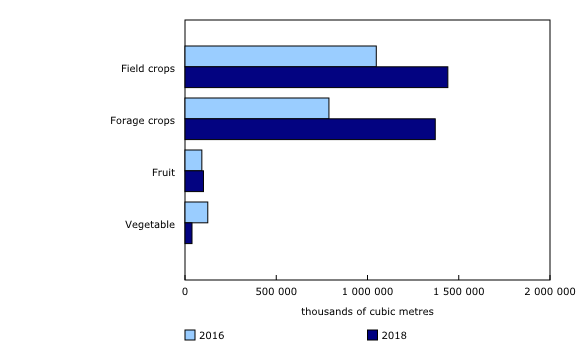Agricultural Water Survey, 2018
Archived Content
Information identified as archived is provided for reference, research or recordkeeping purposes. It is not subject to the Government of Canada Web Standards and has not been altered or updated since it was archived. Please "contact us" to request a format other than those available.
Released: 2019-09-12
Canadian farmers used about one-third more water to irrigate their crops in 2018 compared with two years earlier, mostly as a result of dry weather conditions in Western Canada. Most of the irrigated water was used for field or forage crops.
Canadian agricultural producers used approximately 2.95 billion cubic metres of water to irrigate their crops in 2018. This is equivalent to the volume of water that flows over Niagara Falls over a two-week period.
Total volumes used for irrigation during the growing season were down in every province except Saskatchewan, Alberta and British Columbia. These three provinces experienced very dry conditions in 2018, and farms in these areas reported using 35% more water by volume compared with 2016, accounting for 96% of all the irrigation water applied in the country (2.82 billion cubic metres).
Alberta irrigation water volume increased by 27% from 2016 to 1.9 billion cubic metres in 2018, accounting for approximately two-thirds of the irrigation water applied to crops nationally.
Field (49%) and forage (46%) crops used the most irrigation water across the country, with fruit (3%) and vegetable (1%) crops accounting for the rest.
Most farms (6,380 farms) that irrigated reported no issues preventing irrigation in 2018, but some producers did stop or forego irrigation, citing a shortage of water (715 farms) or poor water quality (595 farms). In 2018, 845 farms did not irrigate for other reasons, such as having received enough rain and/or flooding.
Alberta accounts for over two-thirds of the land that receives irrigation
Nationally, just over 691 000 hectares of land received irrigation in 2018, up slightly (+0.3%) from 2016. Provincially, farmland in Alberta received the most irrigation (472 549 hectares), accounting for over two-thirds of the total area of irrigated land in Canada.
Canadian farmers reported that field (401 700 hectares) or forage (232 461 hectares) crops accounted for the vast majority of irrigated land. Fruit (26 481 hectares) and vegetable (30 466 hectares) crops were also irrigated.
Most off-farm water sources are from provincial authorities
Off-farm water was the most frequently reported source for watering crops in Canada, accounting for two-thirds (68%) of irrigation water. Just over one-quarter of farmers reported on-farm surface water (27%) as a source, followed by on-farm groundwater (3%). As was the case in 2016, off-farm water was the major water source for Alberta, Saskatchewan and British Columbia, while the majority of irrigation water in Eastern Canada came from on-farm surface water sources.
A large portion of the off-farm irrigation water in Canada was provided by provincial sources, led by Alberta (97%), Saskatchewan (90%) and British Columbia (47%). Irrigation water comes from a variety of sources, such as private irrigators, irrigation districts, projects or authorities.
Note to readers
The Agricultural Water Survey gathered information on irrigation water use, irrigation methods and practices, and sources and quality of water used for agricultural purposes on Canadian farms during the 2018 growing season (April 1 to October 31, 2018). This survey is part of the Canadian Environmental Sustainability Indicators program.
The volume of water is reported in cubic metres. One cubic metre equals 1 000 litres.
The area of land that received irrigation refers to land area that actually received irrigation. Land area that had the capacity to be irrigated but did not receive irrigation is not included.
The 2018 survey estimates for both irrigation volume and area of land that received irrigation showed rates that varied widely across regions. Differences in weather patterns, crop types and farming practices can all lead to these variations.
Contact information
For more information, or to enquire about the concepts, methods or data quality of this release, contact us (toll-free 1-800-263-1136; 514-283-8300; infostats@statcan.gc.ca) or Media Relations (613-951-4636; mediahotline@statcan.gc.ca).
- Date modified:


